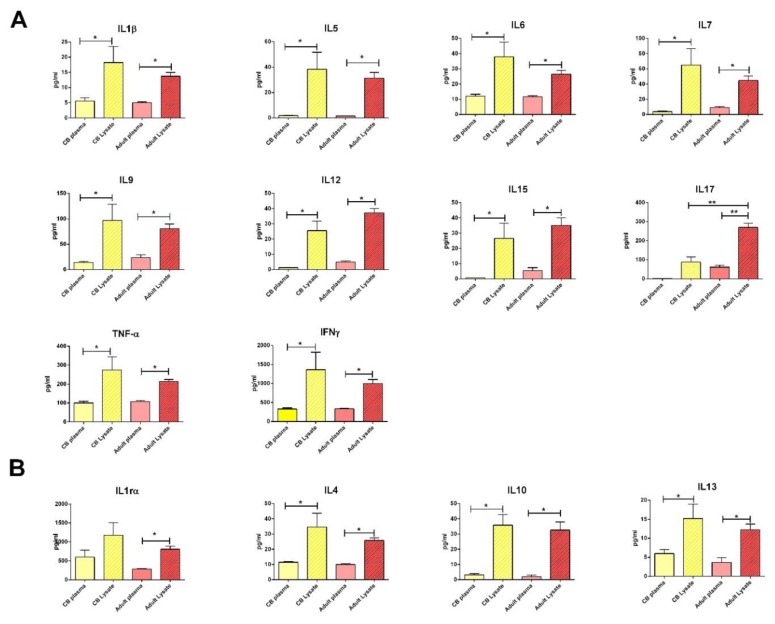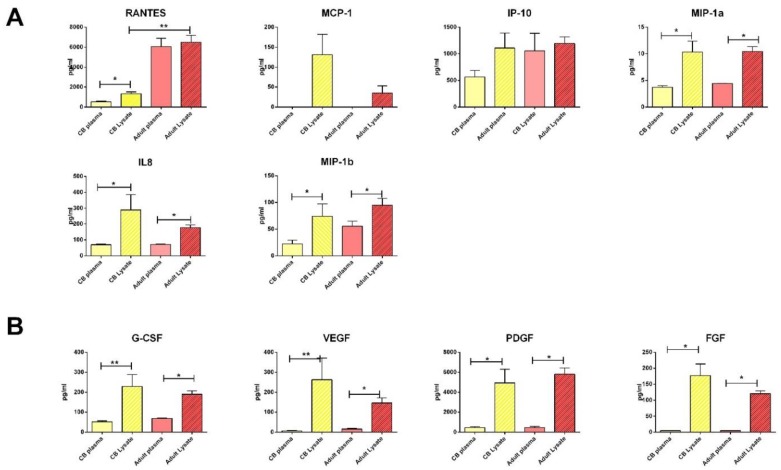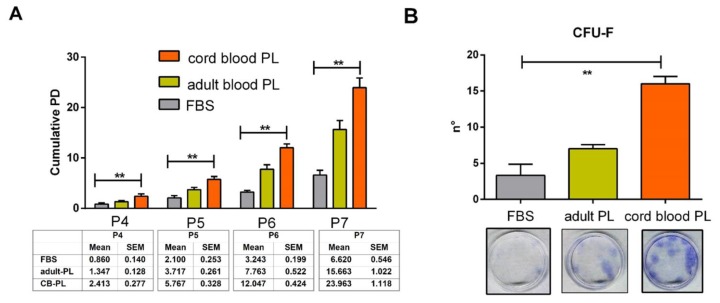Abstract
Platelet-rich plasma (PRP) is an inexpensive and safe substitute of recombinant growth factors in vitro and in vivo. Due to its putative effect on tissue repair, the use of autologous PRP has become largely popular. Recently, a jellified PRP derivative obtained from umbilical cord blood (CB) has been utilized in vivo to treat mucosal and cutaneous lesions. Nevertheless, whether PRP derived from CB and adult blood display different potency in promoting cell growth in vitro has been rarely investigated. In this study, we compared cytokine profile and mesenchymal cell growth supporting the ability of platelet lysate obtained from adult and cord blood. Our in vitro results strongly back the utilization of CB platelet lysate in vivo, as an efficacious, safe and inexpensive alternative to promote damaged tissue healing when the autologous PRP is contraindicated. Moreover, the policy of manufacturing CB platelet lysate can limit the current disposal of many collected CB units not suitable for transplant due to their low nucleated cell count.
Keywords: Platelet lysate, Umbilical blood, Growth factors
Introduction
Platelets are a natural reservoir of growth factors for several cell lineages. Their activation at sites of tissue injury promotes cell proliferation and tissue repair, including revascularization. For this reason, human platelet lysate (PL) is considered a less expensive and safer substitute for recombinant growth factors or animal-derived products.1,2 PL obtained from platelet-enriched- plasma (PRP) contains additional factors, such as fibrinogen and other extracellular matrix precursors, which further promote cell adhesion and tissue repair.3 Due to its putative effect on tissue repair, the use of autologous PRP has become largely popular.4 In fact PRP and derivatives are currently used in the context of musculoskeletal disease such as soft tissue injuries, bone fractures, orthopedic surgery, osteoarthritis, joint degeneration, and wound care,5 but also in ophthalmology to promote epithelial healing,6,7 or in cosmetology and dermatology.8 Recently, the standardized production of a jellified PRP derivative obtained from umbilical cord blood (CB) has been reported.9 The CB platelet gel has shown in vivo positive results in epidermolysis bullosa,10,11 in diabetic foot ulcer healing,12 and in mucositis caused by chemotherapy.13
It is widely acknowledged that cord blood contains a high amount of growth factors. Nevertheless, there are very few studies investigating whether cord and adult PLs display different potency in promoting cell growth in vitro.14 Similarly, the types of cytokines and growth factors released by fetal platelets have been only partially investigated.14,15
Materials and Methods
Platelet lysate manufacture
CB PL was manufactured from CB units collected for solidary donation purpose at the UNICATT Cord Blood Bank, according to the Bank standard procedures and national regulation. CB units were collected in citrate-phosphate-dextrose. The units collected in the previous 24 hours, not suitable for transplant due to a total nucleated cell content <1.5 x109, were utilized in the study. All units displayed cell blood count within the normal ranges, no signs of clots or hemolysis and negative direct antiglobulin test, Adult PL was manufactured from blood collected in sodium citrate in four healthy female volunteers, after informed consent. Samples were maintained at 2–6°C until processing. PL was obtained according to a two-step procedure. In the first step, a PRP was obtained by soft centrifugation (246 g for 25 min) without a break. The PLT concentration of PRP was then assessed using the ADVIA 2120 (Siemens Healthcare Diagnostics, IL, USA). A final PLT concentration of 1.5 × 106/μl was obtained in all PRP samples through further centrifugation at 2218 g for 10 min and the subsequent removal of a plasma aliquot, which was calculated according to the following formula: PRP volume - (PRP volume x [PLT]/1.5). The standardized PRP so obtained, together with the aliquots of the relative plasma previously removed, were frozen at −80°C. Before the use, PL was thawed at 37°C, then again frozen at −80° to favor the platelet lysis, and finally thawed and subjected to centrifugation at 2218 g for 10 min.
Mesenchymal cell cultures
Mesenchymal cells (MSCs) were obtained from bone marrow (BM) samples of a healthy BM donor using residual nucleated cells recovered from filters utilized for the BM graft filtration, after repeated washed with PBS. After a density gradient centrifugation (Lympholyte-H, Cedarlane Lab, Canada), mononuclear cells were then collected and seeded at 10×106 /ml in αMEM (Lonza, Italy) containing 20% FBS (Life Technologies, USA). After three days, non-adherent cells were discharged, and adherent cells were left to grow until confluence. Cultures were maintained at 37°C in humidified 5% CO2 atmosphere, and the medium was changed twice a week. When 80% of confluence was achieved, MSCs were detached by Trypsin 1mM EDTA (Sigma Aldrich, Italy), counted and sub-cultured in the same medium containing 10% FBS. The cell population doubling (PD) rate was calculated in MSC cultures after the passage 3 as previously reported,14 according to the formula PD = log10(N)/log10(2), where N was the ratio between harvested and seeded cells. The colony forming unit-fibroblast (CFU-F) assay was performed by seeding MSCs (from passage 5 or higher), in 60 mm dishes at a concentration of 1–2 cell/cm2 in αMEM and 20% FBS.14 After two weeks of culture, colonies were counted, fixed and visualized by crystal violet staining. In order to compare the effect of CB and adult blood PLs, FBS was substituted by 20% of PL obtained either pooling the eight samples of CB PLs or the four samples of adult blood PLs.
Cytokine assay
The cytokine and growth factors profile were evaluated in adult and CB starting plasma samples and in final adult and CB PL products. The Bio-Plex Human Cytokine 27-Plex Assay and the Bio-Plex MAGPIX™ Multiplex Reader (Bio-Rad, CA, USA) were utilized. The following molecules were dosed: growth factors (G-CSF, GM-CSF, VEGF, FGF, PDGF), chemokines (MCP-1/CCL2, MIP-1a/CCL3, MIP-1b/CCL4, RANTES/CCL5, Eotaxin/CCL11, IP-10/CXCL10), interleukins (IL-1β, IL-1RA, IL-2,IL-4, IL-5, IL-6, IL-7, IL-8, IL-9, IL10, IL-12, IL-13,IL-15, IL-17), and pro-inflammatory mediators (TNF-α, INF-γ). All samples were evaluated in duplicate, according to the manufacturer’s instructions.
Statistics
Continuous variables were expressed as mean values ± standard error (SEM), and they were analyzed through the Mann-Whitney U test or the Kruskal-Wallis test. The GraphPad PRISM 5.0 software and the IBM SPSS Statistics 21.0 software were utilized. The p-value <0.05 were regarded as statistically significant.
Results and Discussion
Cord and adult blood platelet lysates display similar profiles of bioactive molecules
Figure 1 shows results obtained in cord and adult plasma samples and in their corresponding PLs. Relative to adult PLs, our findings are in agreement with those previously reported by Mussano et. al, demonstrating detectable amounts of all investigated analytes using the same methodology.15 In particular, PLs from either adult or cord blood exhibited a higher concentration of all investigated mediators than the corresponding plasma samples, including pro- and anti-inflammatory cytokines (Figure 1 A and Figure 1 B, respectively), chemokines (Figure 2 A) and growth factors (Figure 2 B). Notably, the only significant difference emerging from the comparison between adult and cord blood PLs was the higher concentration of IL17 and RANTES in adult PLs (Figure 1 A and Figure 2 A). This finding is not surprising, considering that both molecules are main players in the innate immunity response.16,17 In fact, cord blood samples used in this study were collected from healthy term babies, whose innate immune system was totally inexperienced. A previous study carried out in CB platelet gel demonstrated that this product underactivation releases VEGF, PDGF-BB, FGF, hepatocyte growth factor and transforming growth factor-β1.18 These findings were subsequently confirmed at the proteomic analysis of cord blood plasma and platelet gel releasate, showing higher levels of angiogenic factors in comparison with the peripheral blood counterparts.14 The authors also found that products obtained from adult blood were much richer in inflammatory factors.14 The discrepancies between these data and our results might have various explanations, including the use of different methodologies (proteomic array and Bioplex analysis) and product characteristics (platelet gel release and platelet lysate). Moreover, a large interindividual variability has been reported among adults regarding the PRP content of bioactive molecules.15
Figure 1.
Mean values ± SEM of cytokine levels in plasma and platelet lysates obtained from cord blood (yellow columns) and adult blood (red columns). (A) Inflammatory cytokines (B) Anti-inflammatory cytokines. * = p < 0.05; ** = p <0.01.
Figure 2.
Mean values + SEM of cytokine levels in plasma and platelet lysates obtained from cord blood (yellow columns) and adult blood (red columns). (A) Chemokines (B) Growth factors * = p < 0.05; ** = p <0.01.
Cord platelet lysates more efficiently promote cell proliferation than their adult blood counterparts
The kinetic of MSC expansion in cultures supplemented with FBS, adult PLs or CB PLs is shown in Figure 3A. As shown by the cumulative PD of three single experiments, CB PLs (obtained by mixing 8 single PLs samples in 3 different pools) were significantly more active in supporting MSC growth over the whole time of culture (p < 0.001 at every passage). Similarly, fibroblast colony yield in the presence of CB PLs was significantly higher than in culture supplemented with FBS or adult PLs (p = 0.003; Figure 3 B). On the whole, our data are in partial agreement with those reported by Parazzi et al. in adipose tissue-derived MSCs.14 In fact, the authors found no difference between adult and cord blood platelet releasate in supporting cell proliferation, whereas both were much more active than FBS.14 The use of MSCs from different sources (BM in our study and adipose tissue in Parazzi’ study), in addition to the use of different PRP derivatives (platelet releasate and platelet lysate), may account for these differences.
Figure 3.
Cord blood and adult blood platelet lysates activity in MSCs cultures (mean values of three different experiments). A) Cumulative population doubling (PD) index in BM derived MSCS supplemented with 10% FBS (grey columns), or platelet lysates form adult (yellow columns) or cord (orange columns) blood. B) Number of CFU-F obtained in the same culture conditions; the representative image of the CFUF culture after staining is shown under each corresponding culture condition. ** = p < 0.01.
Conclusions
This study investigated the biologic characteristic of a PRP derivative of cord blood, expanding the findings previously gathered in a similar product. Although we found no prominent differences regarding the cytokine and growth factor profiles between adult and cord blood samples, cord blood PLs were much more effective in supporting cell proliferation in vitro, suggesting that additional factors, not included in our cytokine array, might be implicated. This hypothesis is supported by previous observations highlighting a differential content of proteins between adult and cord blood-derived platelet gels.19,20 On the whole, these findings may help to identify future appropriate clinical applications better.
In conclusion, our data strongly support the exploitation of cord blood PLs in vitro and prompt its utilization in vivo, to promote damaged tissue healing. Notably, this could be a more efficacious and safer alternative to the autologous PRP. Indeed, cord blood platelet lysate could be a valid alternative in case of contraindication to the autologous PRP for patient refusal or discomfort, unsuitability of venous accesses, or coexistence of inflammatory, autoimmune or hematological diseases. In the meanwhile, the manufacture of CB derivative as medical products for local use, could limit the current disposal of several CB units collected for solidary donation, and not suitable for transplant due to their low nucleated cell count.
Acknowledgments
This work was supported by Fondi d’Ateneo, Progetti D1 2017 Università Cattolica to Luciana Teofili. The authors are in debt to the staff of the Unicatt Cord Blood Bank for their indefatigable work.
Footnotes
Competing interests: The authors have declared that no competing interests exist.
References
- 1.Hofbauer P, et al. Human platelet lysate is a feasible candidate to replace fetal calf serum as medium supplement for blood vascular and lymphatic endothelial cells. Cytotherapy. 2014;16:1238–1244. doi: 10.1016/j.jcyt.2014.04.009. [DOI] [PubMed] [Google Scholar]
- 2.Kim H, et al. Human platelet lysate improves human cord blood derived ECFC survival and vasculogenesis in three dimensional (3D) collagen matrices. Microvasc Res. 2015;101:72–81. doi: 10.1016/j.mvr.2015.06.006. [DOI] [PMC free article] [PubMed] [Google Scholar]
- 3.Seiffert D, Schleef RR. Two functionally distinct pools of vitronectin (Vn) in the blood circulation: identification of a heparin binding competent population of Vn within platelet alpha-granules. Blood. 1996;88:552–560. [PubMed] [Google Scholar]
- 4.Harm SK, Fung MK. Platelet-rich plasma injections: out of control and on the loose? Transfusion. 2015;55(7):1596–8. doi: 10.1111/trf.13160. [DOI] [PubMed] [Google Scholar]
- 5.Platelet-rich plasma injections for wound healing and tissue rejuvenation: a review of clinical effectiveness, cost-effectiveness and guidelines. Ottawa: CADTH; 2017. Jun, [Last accessed November 5, 2018]. (CADTH rapid response report: summary with critical appraisal). Available at https://www.cadth.ca/sites/default/files/pdf/htis/2017/RC0885%20PRP%20Injections%20Final.pdf. [PubMed] [Google Scholar]
- 6.Alio JL, Rodriguez AE, WróbelDudzińska D. Eye platelet-rich plasma in the treatment of ocular surface disorders. Curr Opin Ophthalmol. 2015;26(4):325–32. doi: 10.1097/ICU.0000000000000169. [DOI] [PubMed] [Google Scholar]
- 7.Valentini CG, Nuzzolo ER, Orlando N, Metafuni E, Bianchi M, Chiusolo P, Zini G, Teofili L. Cytokine profile of autologous platelet-derived eye drops in patients with ocular chronic graft-versus-host disease. Vox Sang. 2016;110(2):189–92. doi: 10.1111/vox.12325. [DOI] [PubMed] [Google Scholar]
- 8.Zhang M, Park G, Zhou B, Luo D. Applications and efficacy of platelet-rich plasma in dermatology: A clinical review. J Cosmet Dermatol. 2018;17:660–665. doi: 10.1111/jocd.12673. [DOI] [PubMed] [Google Scholar]
- 9.Rebulla P, Pupella S, Santodirocco M, Greppi N, Villanova I, Buzzi M, De Fazio N, Grazzini G Italian Cord Blood Platelet Gel Study Group (see Appendix 1) Multicentre standardisation of a clinical grade procedure for the preparation of allogeneic platelet concentrates from umbilical cord blood. Blood Transfus. 2016;14(1):73–9. doi: 10.2450/2015.0122-15. [DOI] [PMC free article] [PubMed] [Google Scholar]
- 10.Gelmetti A, Greppi N, Guez S, Grassi F, Rebulla P, Tadini G. Cord blood platelet gel for the treatment of inherited epidermolysis bullosa. Transfus Apher Sci. 2018;57:370–373. doi: 10.1016/j.transci.2018.05.021. [DOI] [PubMed] [Google Scholar]
- 11.Tadini G, Pezzani L, Ghirardello S, Rebulla P, Esposito S, Mosca F. Cord blood platelet gel treatment of dystrophic recessive epidermolysis bullosa. BMJ Case Rep. 2015 Jan 8;:2015. doi: 10.1136/bcr-2014-207364. [DOI] [PMC free article] [PubMed] [Google Scholar]
- 12.Volpe P, Marcuccio D, Stilo G, Alberti A, Foti G, Volpe A, Princi D, Surace R, Pucci G, Massara M. Efficacy of cord blood platelet gel application for enhancing diabetic foot ulcer healing after lower limb revascularization. Semin Vasc Surg. 2017;30:106–112. doi: 10.1053/j.semvascsurg.2017.12.001. [DOI] [PubMed] [Google Scholar]
- 13.Piccin A, Rebulla P, Pupella S, Tagnin M, Marano G, Di Pierro AM, Santodirocco M, Di Mauro L, Beqiri L, Kob M, Primerano M, Casini M, Billio A, Eisendle K, Fontanella F. Impressive tissue regeneration of severe oral mucositis post stem cell transplantation using cord blood platelet gel. Transfusion. 2017;57(9):2220–2224. doi: 10.1111/trf.14205. [DOI] [PubMed] [Google Scholar]
- 14.Parazzi V, Lavazza C, Boldrin V, Montelatici E, Pallotti F, Marconi M, Lazzari L. Extensive Characterization of Platelet Gel Releasate From Cord Blood in Regenerative Medicine. Cell Transplant. 2015;24(12):2573–84. doi: 10.3727/096368915X687471. [DOI] [PubMed] [Google Scholar]
- 15.Mussano F, Genova T, Munaron L, Petrillo S, Erovigni F, Carossa S. Cytokine, chemokine, and growth factor profile of platelet-rich plasma. Platelets. 2016 Jul;27(5):467–71. doi: 10.3109/09537104.2016.1143922. [DOI] [PubMed] [Google Scholar]
- 16.Gaffen SL. An overview of IL-17 function and signaling. Cytokine. 2008 Sep;43(3):402–7. doi: 10.1016/j.cyto.2008.07.017. [DOI] [PMC free article] [PubMed] [Google Scholar]
- 17.Levy JA. The unexpected pleiotropic activities of RANTES. J Immunol. 2009 Apr 1;182(7):3945–6. doi: 10.4049/jimmunol.0990015. [DOI] [PubMed] [Google Scholar]
- 18.Parazzi V, Lazzari L, Rebulla P. Platelet gel from cord blood: a novel tool for tissue engineering. Platelets. 2010;21(7):549–54. doi: 10.3109/09537104.2010.514626. [DOI] [PubMed] [Google Scholar]
- 19.Longo V, Rebulla P, Pupella S, Zolla L, Rinalducci S. Proteomic characterization of platelet gel releasate from adult peripheral and cord blood. Proteomics Clin Appl. 2016 Aug;10(8):870–82. doi: 10.1002/prca.201500126. [DOI] [PubMed] [Google Scholar]
- 20.Stokhuijzen E, Koornneef JM, Nota B, van den Eshof BL, van Alphen FPJ, van den Biggelaar M, van der Zwaan C, Kuijk C, Mertens K, Fijnvandraat K, Meijer AB. Differences between Platelets Derived from Neonatal Cord Blood and Adult Peripheral Blood Assessed by Mass Spectrometry. J Proteome Res. 2017 Oct 6;16(10):3567–3575. doi: 10.1021/acs.jproteome.7b00298. [DOI] [PubMed] [Google Scholar]





